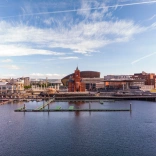1557 – The equals sign
Robert Recorde (1512-1558) led a busy, learned life. Born in Tenby, he attended Oxford and Cambridge universities, and became both physician to Edward VI and controller of the Royal Mint. His chief contribution to mathematics, however, was inventing the equals sign (=), which he used in his 1557 book The Whetstone of Witte: ‘to avoid the tedious repetition of these words – is equal to – I will set a pair of parallels lines of one length, because no two things can be more equal.’
1706 – Pi
The Anglesey-born mathematician William Jones (1675-1749) didn’t invent pi, the numerical value of the ratio of the circumference of a circle to its diameter, but he was the first to use the, now universally-recognised, Greek symbol ‘π’ to represent it (most likely because it is the first letter of the Greek word περίμετρος – 'perimeter').

1721 – The Jolly Roger
Many pirates were said to have sailed under a version of the Jolly Roger, the famous black flag with a skull and crossbones motif, but historians are unsure of exactly how it got its unusual name. What we do know, however, is that the first written reference to a “Jolly Roger” appears in the 1724 book, A General History of the Pyrates, where the unusual moniker is attributed to the fabled Welsh pirate, Bartholomew Roberts. Something of a fashionista, Bartholomew is said to have dressed in crimson, leading some to speculate the title “Jolly Roger” comes from the nickname the fearsome Welshman was supposedly given by the French: Le Jolie Rouge (The Pretty Red).
1794 – Ball bearings
The Carmarthen-based inventor and ironmaster Philip Vaughan patented the first design for a ball bearing in 1794. His design placed iron balls between the wheel and the axle of a carriage, allowing the carriage wheels to rotate freely by reducing friction. His 18th-century design is fundamentally unchanged in all rotating machines and vehicles today.
1807 – Passenger railway lines
It’s the mischievous kids of the Welsh city of Swansea that we all have to thank for modern-day passenger railway trains. When the owners of the industrial railway track that ran between the quarries of Mumbles and the canal in Swansea saw local children hitching a ride on the horse-pulled carts they realised there was scope for railways to transport passengers as well as goods. The necessary adaptations were made, and, in 1807, the Mumbles Railway opened as the first fee-paying passenger railway service in the world.
1836 – Iron smelting
The ‘hot blast’ process – pre-heating the air before it’s pumped into a blast furnace – revolutionised iron-making. It was discovered independently by several ironworkers, including David Thomas (1794- 1882) at Ystradgynlais, Powys. Thomas took his process to Pennsylvania, where he played an important role in US industry, and became the first president of the American Society of Metallurgy.

1842 – The fuel cell
In the future, everyone may drive cars powered by hydrogen fuel cells – thanks to Sir William Grove (1811-1896). The Swansea-born lawyer-turned-scientist invented the fuel cell in 1842, which combined hydrogen and oxygen to produce electricity. As a lecturer at the London Institution, Grove also demonstrated how electric current could be used to create light, a concept that would be perfected by Thomas Edison with his light bulb three decades later.
1861 – Mail-order shopping
When the small community of Newtown in mid-Wales was connected to the UK railway network in the mid-19th century, one local draper, Sir Pryce Jones (1834-1920), saw an opportunity to expand his customer base. By using trains to deliver his products, Jones pioneered the world’s first major mail-order business, eventually supplying garments to customers as far afield as America and Australia, as well as to a number of famous clients, including Florence Nightingale and Queen Victoria.

1874 - Tennis
The early history of tennis is somewhat hazy, with its creation linked to the French monarch Louis X (who purportedly died after a particularly intense game...), and even to one of King Arthur’s knights, who is said to have played a match against 17 giants. One man who certainly had a hand in getting the sport off the ground, however, is the Welsh inventor, Walter Clopton Wingfield. An early fan of the game, Walter began selling popular tennis sets that included rubber balls, a net, poles, court markers, and an instruction manual, allowing the sport to be played almost anywhere. As a result, he is listed in the International Tennis Hall of Fame as “a founder of modern lawn tennis”.
1878 – The microphone
Debate continues about whether David Edward Hughes (1831-1900) was born near Corwen, North Wales, or in London (though records show his father was a bootmaker from Bala in Gwynedd). But what is certain is the scientist invented the first working radio communication system, as well as the first microphone, a breakthrough that paved the way for the emergence of the telephone industry in the 20th century. The Royal Society’s Hughes Medal, an annual award given to pioneering scientists, is named in his honour.
1880 – Medicine and social reform
Frances Hoggan (nee Morgan; 1843-1927) was only the second woman in Europe to earn a medical doctorate. She became a specialist in women’s and children’s diseases, and later campaigned tirelessly to promote education for girls in Wales, and around the world. The Learned Society of Wales presents the annual Frances Hoggan Medal to recognise the contribution of outstanding women in science, technology, engineering, medicine or mathematics.

1884 – Cremation
Cremation wasn’t invented in Wales, but it was legalised in the UK thanks to one, rather eccentric, Welshman. William Price (1800-1893) was a doctor and self-professed Neo-Druid (he also believed he was chosen by god to remove Wales from English control), who opted to cremate his son on a Llantrisant hilltop following his death, an act that was considered blasphemous at the time. In court, Price successfully argued that while cremation was not legal in the UK, it was also not illegal. The case paved the way for the Cremation Act of 1902. Today, a statue stands of Price in the town of Llantrisant.
1886 – Deep space photography
A farmer’s son from Denbighshire, Isaac Roberts (1829-1904) solved the problem of how to keep a camera pointing at faint celestial objects, which require very long exposures, while the earth is continuously rotating beneath us. He took the first picture of the spiral Andromeda Galaxy, which revealed its true form to astronomers for the first time.

1894 – Early flight
Mankind’s first shaky stretch towards the heavens will forever be synonymous with the Wright Brothers, who, in 1903, flew their rickety motorised plane over a section of North Carolina parkland. However, a number of pioneering aviators claim to have built powered flying machines before the Wrights, including William Frost (1848-1935), from Pembrokeshire, whose Frost Airship Glider was officially patented at the end of the 19th century. Frost is said to have flown his airship on a Pembrokeshire beach in 1896, seven years before the Wright Brothers took to the sky. Unfortunately, no photos exist from the event, and, to make matters worse, a storm destroyed the airship the following night. The airship’s patent is certainly real, but whether Frost ever flew his creation remains a mystery.
1896 – Public health and politics
Born in Llandudno, Dr Martha Hughes Cannon (1857-1932) emigrated to the United States where she worked as a physician, suffragist and public health reformer. In 1896 she became the first female US state senator – running against, and defeating, her own husband. She proposed several legislative bills that revolutionized public health in Utah, where the present Department of Health building, in Salt Lake City, is named in her honour.

1904 – The spare wheel
Morris and Walter Davies opened an ironmongery shop in Llanelli’s Stepney Street in 1895. Early motor cars carried no spare tyres, so Morris Davies invented a spokeless wheel rim fitted with an inflatable tyre. By 1909 all London taxis carried the device, and their invention spread throughout the world. Even today, a spare wheel is commonly called a ‘stepney’ in many countries.
1935 – Radar
The son of a Swansea steelworker, Edward ‘Taffy’ Bowen (1911-1991) was a key figure in the development of radar. Bowen was a member of the team tasked with creating a radar system that could be installed onto aircrafts, allowing the crew to detect not only other planes but also hard-to-find targets like submarines for the first time – an innovation that greatly aided the allies during WWII. After the war, he became a pioneer of radio astronomy.

1963 – The RIB Boat
With its location on the south coast of Wales, within splashing distance of the wild waves of the Bristol Channel, Atlantic College feels like a fitting site for a boating design breakthrough that would ultimately make seafaring safer for all. During the 1960s, a team of staff and students from the Welsh college – which boasts alumni from around the world (as well as from several royal families!) – built the first rigid inflatable boat, or RIB, a craft with a solid bottom and inflated sides, making it both light and sturdy. The patent for the innovative craft was purchased from the college (for the princely sum of £1) by the Royal National Lifeboat Institution (RNLI), who used the design as a model for their inshore lifeboats, still used today.
1965 - Packet switching
Treorchy-born computer scientist Donald Davies (1924-2000) worked with Alan Turing on early British computers, but his 1965 breakthrough in ‘packet switching’ – dividing computer messages into packets that are routed independently across a network – is one of the key founding principles of the internet.
1972 – Anthropology
Elaine Morgan (1920-2013) was an acclaimed TV scriptwriter, but in scientific circles is best known for her work on evolutionary anthropology, especially the aquatic ape hypothesis (the idea that the ancestors of humans became adapted to marine environments). Elaine published several books on the topic, including The Descent of Woman (1972) and The Aquatic Ape Hypothesis (1997). Both books also challenged what Morgan perceived as the traditional male-centred view of human evolution, where the role of the female of the species is often overlooked.

1976 – The electronic breathalyser
Tom Parry Jones (1935-2013), originally from Anglesey, invented the electronic breathalyser in 1976, a device used to detect intoxicated drivers and keep roads safe. Jones developed the device at Lion Laboratories, which he founded in Cardiff, and was awarded an OBE for his work. Today, products made by Lion Laboratories, now located in Barry, are still used by the UK police and in 70 countries worldwide.
1977 – Pot Noodle
Yes, the longstanding student snack of choice is actually Welsh. Well, sort of. Though created by Scottish company Golden Wonder (based on cup noodle products that were already popular in Japan), the organisation’s factory in Crumlin, near Caerphilly, was the site chosen to produce the minimal-effort, meal-in-a-tub when it was unleashed upon the British public in 1977 – and they’re still made there today.
1992 – Viagra
We’d face some… ahem… stiff resistance if we claimed this famous erectile dysfunction drug was a truly Welsh invention, but the effects of Viagra were first discovered in a former mining town in South Wales. Viagra, then known as Sildenafil, was originally conceived as a treatment for the chest condition angina, but after the men in Merthyr Tydfil who signed up to trial the new pill admitted to experiencing some unexpected symptoms, the drug was swiftly rebranded as a libido enhancer, now sold all over the world.




